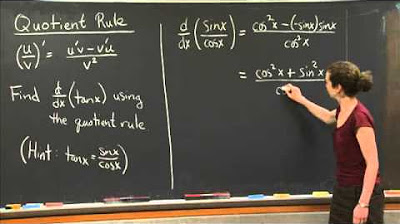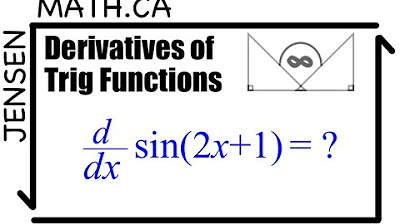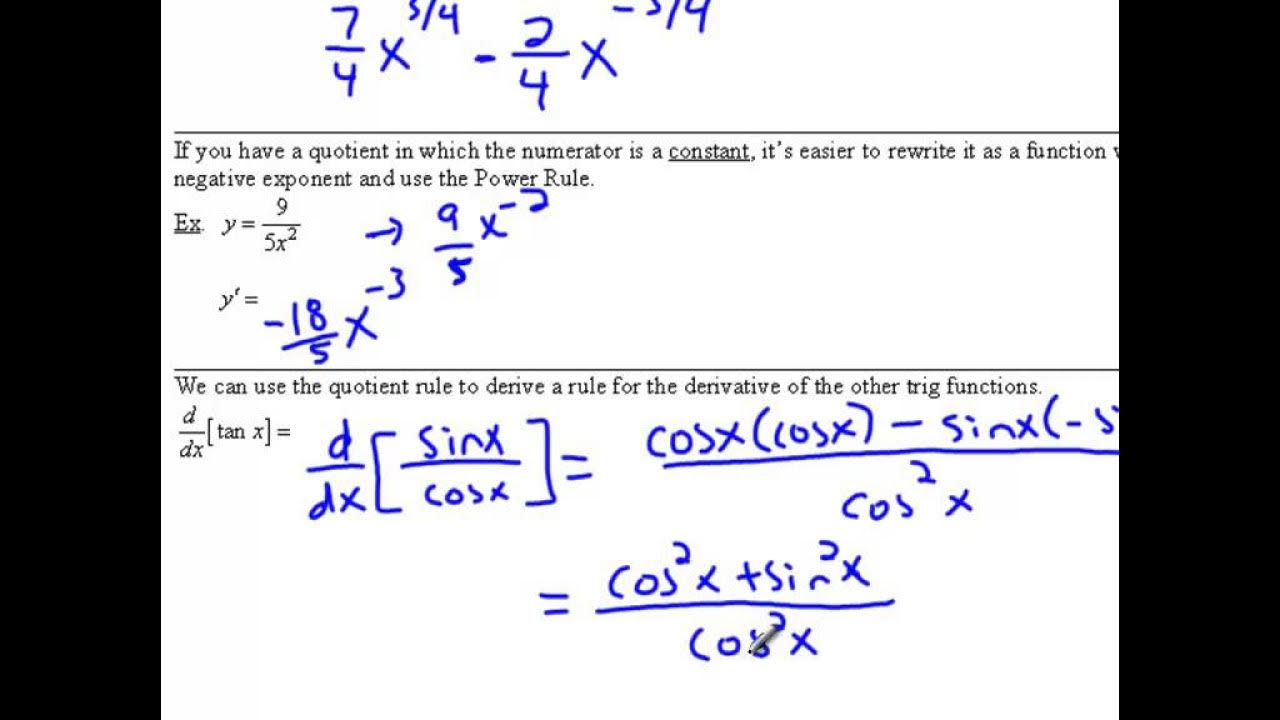Derivatives of Trigonometric Functions - Product Rule Quotient & Chain Rule - Calculus Tutorial
TLDRThis video script offers an in-depth exploration of the derivatives of trigonometric functions, essential for calculus students. It begins by listing the derivatives of basic trigonometric functions, such as sine, cosine, and tangent, and then extends to more complex ones like cosecant, cotangent, and secant. The script uses the power rule and the product, quotient, and chain rules to derive the first derivatives of various trigonometric expressions, including composite functions. It also demonstrates how to apply these rules to solve problems involving functions like x cubed plus sine x plus 4 cosine x. The video concludes with proofs for the derivatives of secant and cotangent functions, reinforcing the understanding of the underlying mathematical principles. The comprehensive approach and step-by-step explanations make this script a valuable resource for grasping the intricacies of trigonometric derivatives.
Takeaways
- 📚 The derivative of sin(x) is cos(x), which is a fundamental rule for differentiation of trigonometric functions.
- 📉 The derivative of cos(x) is -sin(x), indicating a negative relationship between the derivative of cosine and sine.
- 📈 The derivative of tan(x) is sec^2(x), which involves the secant function squared.
- 🔄 A pattern exists for derivatives with a 'c' in the function name (cosec, cotan), as they tend to have a negative sign in front.
- 👆 The power rule for derivatives states that the derivative of x^n is n*x^(n-1), which is crucial for polynomial functions.
- 🤝 The product rule for derivatives is applied when two functions are multiplied, expressed as (f'g + fg') for functions f and g.
- ➗ The quotient rule for derivatives is used for rational functions, given by (g*f' - f*g') / g^2, where f and g are the numerator and denominator functions, respectively.
- ⛓ The chain rule is essential for composite functions, expressed as f'(g(x)) * g'(x), where f is the outer function and g is the inner function.
- 🔢 For composite functions involving trigonometric functions, apply the chain rule by differentiating the outer function and then multiplying by the derivative of the inner function.
- 📌 Memorizing the derivatives of the six basic trigonometric functions is key to solving more complex trigonometric differentiation problems.
- 📐 The proof of derivatives for secant and cotangent functions involves applying the power rule and quotient rule, showcasing the relationship between trigonometric identities and derivatives.
Q & A
What is the derivative of sine(x)?
-The derivative of sine(x) is cosine(x).
How do you find the derivative of a function that is a product of two functions?
-You use the product rule, which states that the derivative of a function f(x) times g(x) is f'(x) times g(x) plus f(x) times g'(x).
What is the derivative of tangent(x) with respect to x?
-The derivative of tangent(x) with respect to x is secant squared(x).
What is the general rule for memorizing the derivatives of the trigonometric functions that include 'cosecant', 'cosine', or 'cotangent'?
-There is usually a negative sign in front of the derivative when the original function includes 'cosecant', 'cosine', or 'cotangent'.
What is the derivative of x cubed with respect to x?
-The derivative of x cubed with respect to x is 3x squared, according to the power rule.
How do you apply the quotient rule to find the derivative of a function in the form of f(x)/g(x)?
-The quotient rule states that the derivative of f(x)/g(x) is [g(x) * f'(x) - f(x) * g'(x)] / [g(x)]^2.
What is the derivative of the composite function f(g(x))?
-The derivative of the composite function f(g(x)) is f'(g(x)) * g'(x), where f' denotes the derivative of f and g' denotes the derivative of g.
How do you prove that the derivative of secant(x) is secant(x) tangent(x)?
-You use the power rule and chain rule, rewriting secant(x) as 1/cosine(x), then differentiating and simplifying to show it equals secant(x) tangent(x).
What is the derivative of y with respect to x if y equals x squared sine(x)?
-Using the product rule, the derivative is 2x sine(x) plus x squared cosine(x).
How do you find the derivative of a function that includes a trigonometric function inside another, such as tangent(sine(4x))?
-You use the chain rule, differentiating the outer function first while keeping the inner function the same, and then multiply by the derivative of the inner function.
What is the derivative of y with respect to x if y equals sine squared(3x)?
-First, rewrite sine squared(3x) as [sine(3x)]^2, then apply the power rule to get 2 sine(3x) times the derivative of sine(3x), which is 2 sine(3x) times cosine(3x).
Outlines
📚 Introduction to Trigonometric Derivatives
This paragraph introduces the derivatives of basic trigonometric functions. It explains that the derivative of sine(x) is cosine(x), the derivative of cosine(x) is negative sine(x), and the derivative of tangent(x) is secant squared(x). It also covers the derivatives of cosecant(x), cotangent(x), and cotan(x), noting a negative sign is usually associated with functions that include 'co-'. The paragraph then applies this knowledge to find the derivative of a function f(x) = x^3 + sin(x) + 4cos(x), resulting in f'(x) = 3x^2 + cos(x) - 4sin(x).
🔍 Applying Product and Quotient Rules
The second paragraph delves into applying the product and quotient rules for derivatives. It discusses how to find the derivative of a function that is a product of two functions using the formula f'(x)g(x) + g'(x)f(x), and for a quotient, the formula g(x)f'(x) - f(x)g'(x) / g(x)^2. Examples include finding the derivatives of functions like y = x^2sin(x), y = x^3cos(x), and y = sin(x)/x^2, with the latter using the quotient rule. The paragraph emphasizes the importance of factoring out common terms and canceling where possible to simplify the expressions.
🔗 Chain Rule for Composite Functions
The third paragraph focuses on the chain rule for composite functions. It explains that the derivative of a composite function f(g(x)) is found by multiplying the derivative of the outer function f' by the derivative of the inner function g'. The paragraph provides formulas for the derivatives of functions like sine(u), cosine(u), and tangent(u), where u is an inner function. It then applies these formulas to find the derivatives of functions such as f(x) = sin(5x) and f(x) = cos(x^3), demonstrating the process of differentiating from the outside in.
🔧 Power Rule and Trigonometric Derivatives
The fourth paragraph discusses the application of the power rule in conjunction with the derivatives of trigonometric functions. It covers how to handle functions raised to a power, such as secant(x)^2, and how to find the derivative of nested trigonometric functions like tangent(sin(4x)). The paragraph also explains how to rewrite functions to make differentiation simpler, such as squaring sine(3x) and differentiating it using the power rule and chain rule.
📝 Derivatives of Complex Trigonometric Expressions
The fifth paragraph continues with the theme of complex trigonometric expressions, showing how to differentiate expressions like cotangent to the fourth power of sine(x) cubed. It demonstrates the use of the power rule to move exponents outside of functions and the chain rule to differentiate nested functions. The paragraph also covers the differentiation of functions like y = secant(x) squared and y = tangent(sin(4x)), emphasizing the step-by-step process of applying the chain rule.
📐 Proving Derivatives of Trigonometric Functions
The sixth paragraph shifts the focus to proving the derivatives of trigonometric functions, such as secant(x) and cotangent(x). It uses the quotient rule and trigonometric identities to show that the derivative of secant(x) is indeed secant(x)tangent(x) and that the derivative of cotangent(x) is negative cosecant(x) squared. The paragraph emphasizes the importance of understanding the underlying principles of differentiation and the application of trigonometric identities in proving these derivatives.
📝 Final Thoughts and Thanks
The seventh and final paragraph wraps up the video with a brief summary of the concepts covered and a thank you to the viewers. It does not contain substantial mathematical content but serves as a conclusion to the video, encouraging viewers to apply what they've learned and to continue exploring the topic of derivatives.
Mindmap
Keywords
💡Derivative
💡Trigonometric functions
💡Power rule
💡Product rule
💡Quotient rule
💡Chain rule
💡Secant function
💡Cosecant function
💡Cotangent function
💡Tangent function
💡Trigonometric identities
Highlights
Derivative of sine(x) is equal to cosine(x)
Derivative of cosine(x) is equal to negative sine(x)
Derivative of tangent(x) is equal to secant squared(x)
Derivative of cosecant(x) is equal to negative cosecant(x) cotangent(x)
Derivative of secant(x) is secant(x) tangent(x)
Derivative of cotangent(x) is negative cosecant squared(x)
A pattern for derivatives with a 'c' in the function name often includes a negative sign
The derivative of x cubed plus sine(x) plus 4 cosine(x) is 3x squared plus cosine(x) minus 4 sine(x)
Derivatives of functions involving trigonometric functions can be found using the power rule and basic trigonometric derivative properties
Product rule for derivatives is f'(x)g(x) + f(x)g'(x), where f and g are functions of x
Quotient rule for derivatives is [g(x)f'(x) - f(x)g'(x)] / [g(x)]^2 for functions f and g
Chain rule for derivatives involves differentiating the outside function and multiplying by the derivative of the inside function
Derivative of sine(u) is cosine(u) times the derivative of u
Derivative of cosine(x cubed) is negative 3x squared sine(x cubed) using the chain rule
Derivative of secant(x squared) is 2x secant(x squared) tangent(x squared)
Derivative of tangent(sine(4x)) involves applying the chain rule step by step from the outside function inwards
Derivative of sine squared(3x) is 6 sine(3x) cosine(3x) after applying the power rule and chain rule
Derivative of cotangent to the fourth of sine(x cubed) is a complex application of the power rule and chain rule
Proving the derivative of secant(x) is secant(x) tangent(x) involves using the power rule and trigonometric identities
Proving the derivative of cotangent(x) is negative cosecant squared(x) uses the quotient rule and trigonometric identities
Transcripts
Browse More Related Video

Derivatives of Trig Functions (Sin, Cos, Tan) in Calculus - [1-4]

Derivatives of Trigonometric Functions

Quotient Rule | MIT 18.01SC Single Variable Calculus, Fall 2010

Derivatives of Trig Functions - Calculus | MCV4U

Product and Quotient Rule

Calculus 1 Lecture 2.5: Finding Derivatives of Trigonometric Functions
5.0 / 5 (0 votes)
Thanks for rating: